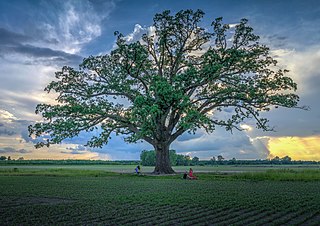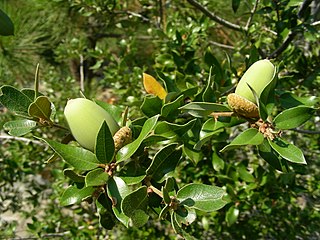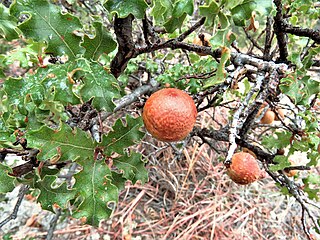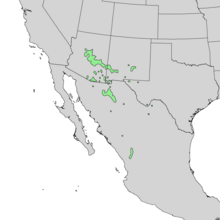
Quercus kelloggii, the California black oak or Kellogg oak, is an oak in the red oak section native to western North America. Although genetically separated from them for more than 20 million years, its leaves are remarkably similar in appearance to several other members of the red oak section including the red oak and the black oak found in eastern and central North America.

Quercus montana, the chestnut oak, is a species of oak in the white oak group, Quercus sect. Quercus. It is native to the eastern United States, where it is one of the most important ridgetop trees from southern Maine southwest to central Mississippi, with an outlying northwestern population in southern Michigan. It is also sometimes called rock oak because of its presence in montane and other rocky habitats.

Quercus alba, the white oak, is one of the preeminent hardwoods of eastern and central North America. It is a long-lived oak, native to eastern and central North America and found from Minnesota, Ontario, Quebec, and southern Maine south as far as northern Florida and eastern Texas. Specimens have been documented to be over 450 years old.

Quercus muehlenbergii, the chinquapinoak, is a deciduous species of tree in the white oak group. The species was often called Quercus acuminata in older literature. Quercus muehlenbergii is native to eastern and central North America. It ranges from Vermont to Minnesota, south to the Florida panhandle, and west to New Mexico in the United States. In Canada it is only found in southern Ontario, and in Mexico it ranges from Coahuila south to Hidalgo.

Quercus velutina, the black oak, is a species of oak in the red oak group, native and widespread in eastern and central North America. It is sometimes called the eastern black oak.

Quercus virginiana, also known as the southern live oak, is an evergreen oak tree endemic to the Southeastern United States. Though many other species are loosely called live oak, the southern live oak is particularly iconic of the Old South. Many very large and old specimens of live oak can be found today in the Deep South region of the United States.

Quercus macrocarpa, the bur oak or burr oak, is a species of oak tree native to eastern North America. It is in the white oak section, Quercus sect. Quercus, and is also called mossycup oak, mossycup white oak, blue oak, or scrub oak. The acorns are the largest of any North American oak, and are important food for wildlife.

Quercus shumardii, the Shumard oak, spotted oak, Schneck oak, Shumard red oak, or swamp red oak, is one of the largest of the oak species in the red oak group. It is closely related to Quercus buckleyi, Quercus texana, and Quercus gravesii.

Quercus gambelii, with the common name Gambel oak, is a deciduous small tree or large shrub that is widespread in the foothills and lower mountains of western North America. It is also regionally called scrub oak, oak brush, and white oak.

Quercus engelmannii, the Engelmann oak or Pasadena oak, is a species of oak in the white oak section, native to southern California and northwestern Baja California, Mexico.

Quercus lyrata, the overcup oak, is an oak in the white oak group. The common name, overcup oak, refers to its acorns that are mostly enclosed within the acorn cup. It is native to lowland wetlands in the eastern and south-central United States, in all the coastal states from New Jersey to Texas, inland as far as Oklahoma, Missouri, and Illinois. There are historical reports of it growing in Iowa, but the species appears to have been extirpated there. It is a slow-growing tree that often takes 25 to 30 years to mature. It has an estimated lifespan of 400 years.

Quercus chrysolepis, commonly termed canyon live oak, canyon oak, golden cup oak or maul oak, is a North American species of evergreen oak that is found in Mexico and in the western United States, notably in the California Coast Ranges. This tree is often found near creeks and drainage swales growing in moist cool microhabitats. Its leaves are a glossy dark green on the upper surface with prominent spines; a further identification arises from the leaves of canyon live oak being geometrically flat.

Quercus pagoda, the cherrybark oak, is one of the most highly valued red oaks in the southern United States. It is larger and better formed than southern red oak and commonly grows on more moist sites. Its strong wood and straight form make it an excellent timber tree. Many wildlife species use its acorns as food, and cherrybark oak makes a fine shade tree. Cherrybark oak was formerly considered to be a subspecies of southern red oak, Quercus falcata, subsp pagodifolia.

Quercus havardii is a deciduous, low-growing, thicket-forming shrub that occupies some two million to three million hectares in the southern Great Plains of North America. Clones may reach hundreds to thousands of years old, although aboveground stems typically live only 11 to 15 years. Shinnery oak stems are usually 1 to 2 metres tall and codominate the plant community with mid- and tall-grasses, which are usually taller than the oaks.

Quercus turbinella is a North American species of oak known by the common names shruboak, turbinella oak, shrub live oak, and gray oak. It is native to Arizona, California, New Mexico, Utah, Colorado, and Nevada in the western United States. It also occurs in northern Mexico.

Quercus pungens, commonly known as the sandpaper oak or scrub oak, is a North American species evergreen or sub-evergreen shrub or small tree in the white oak group. There is one recognised variety, Quercus pungens var. vaseyana, the Vasey shin oak. Sandpaper oak hybridizes with gray oak in the Guadalupe Mountains of New Mexico and Texas.

Quercus oblongifolia, commonly known as the Mexican blue oak, Arizona blue oak, Blue live oak or Sonoran blue oak, is an evergreen small tree or large shrub in the white oak group.

Quercus grisea, commonly known as the gray oak, shin oak or scrub oak, is a North American species deciduous or evergreen shrub or medium-sized tree in the white oak group. It is native to the mountains of the southwestern United States and northern Mexico. It hybridises with four other oak species where the ranges overlap, the Arizona white oak (Q. arizonica), the Gambel oak (Q. gambelii), the Mohr oak (Q. mohriana) and the sandpaper oak (Q. pungens).

Lycium pallidum is a species of flowering plant in the nightshade family known by the common names pale wolfberry and pale desert-thorn. It is native to northern Mexico and the southwestern United States. In Mexico it can be found in Sonora, Chihuahua, Zacatecas, and San Luis Potosi. In the United States it occurs from California to Texas and as far north as Utah and Colorado.

Quercus hypoleucoides, the silverleaf oak or the whiteleaf oak, is a North American species of oak tree or shrub. It grows in the southwestern United States and northern Mexico.























